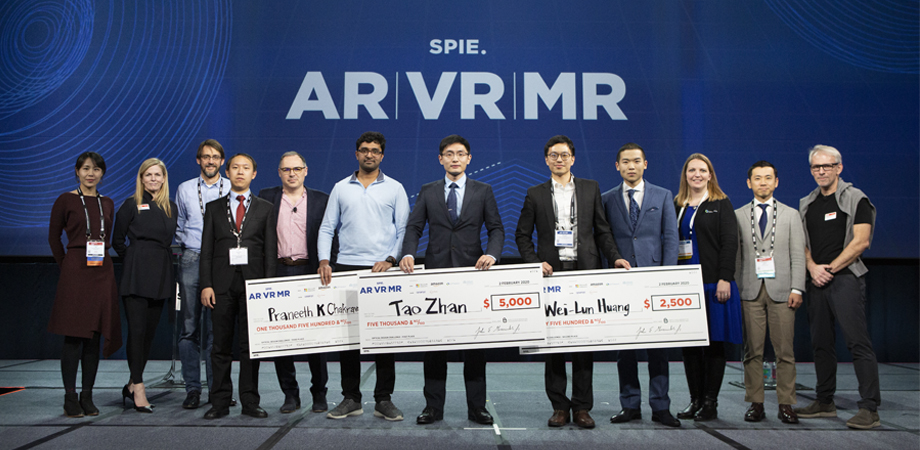2020 AR/VR/MR Student Optical Design Challenge

At the awards ceremony for the 2020 Student Optical Design Challenge - part of the SPIE AR/VR/MR conference in San Francisco - Tao Zhan of CREOL, the College of Optics and Photonics at the University of Central Florida, won the top recognition and $5,000 for his presentation, "Planar optics enables chromatic aberration correction in immersive near-eye displays."
Wei-Lun Huang, of Johns Hopkins University, won second place and $2,500 for "A portable projection mapping device for medical augmented reality in single-stage cranioplasty," and Praneeth Kumar Chakravarthula, of the University of North Carolina of at Chapel Hill, was presented with third prize and a check for $1,500 for "Computing high quality phase-only holograms for holographic displays."
An initial pool of 50 applicants participated in the third Student Optical Design Challenge, a high-energy competition created to help bridge the gap between traditional optical design and tangible industry expectations for contemporary immersive display products. At the same time, the competition - and their eight-minute elevator pitches - exposes the student participants to some of industry's top companies: judges are drawn from across the optical engineering industry and community. This year they included Microsoft's Andreas Georgiou, Nvidia's Kaan Aksit, Applied Materials' Jinxin Fu, Harvard's Zhujun Shi, Optimax's Jessica DeGroote Nelson, Zemax's Sanjay Gangadhara and Katsumoto Ikeda, Google's Jerry Carollo, and University of Arizona's Hong Hua.
Microsoft HoloLens' Bernard Kress and Magic Leap's Christophe Peroz, who were among the judges and are also co-chairs of the Digital Optics conference track and organizers of the Challenge, are both delighted with the direction the competition is taking.
"The first one in 2018 was a shot in the dark," noted Kress. "We didn't really know what we were doing, but we had an amazing number of students who came and an amazing number of sponsors. But it's really the fruits that were generated with some of the previous laureates of this competition that I find exciting: two have already returned, one as a judge and one as an entrepreneur with a product. That's just wonderful, to turn your recognition into this kind of advancement. This competition is really all about the self-confidence that can be generated by industry recognition. Industry looks a bit scary when you are at university: we wanted to bridge university and industry and to show these students that, look, industry is waiting for you. Industry is really hungry for the best optical engineers today and to prove this, they come as sponsors to say, ‘Look, these are our challenges, these are the challenges in AR/VR/MR that industry faces today. What can you do to help us?'"
"We had such a great selection of participating students this year," added Peroz. "I was telling them, ‘This will give you confidence and experience! Show your ideas, pitch the jury.' It's how it's done in industry: you have to make the pitch and sell the solution to the problem. It's a wonderful opportunity - I myself would have loved to be part of something like this - and we really need this kind of event for the students. Because most of these students will end up in the industry. If you get recognition from industry while you're still a student, this can be an amazing push."
Sponsors of the 2020 Student Optical Design Challenge this year were Microsoft HoloLens, Synopsys, Applied Materials, Zemax, Amazon, LightTrans, and Optimax.



